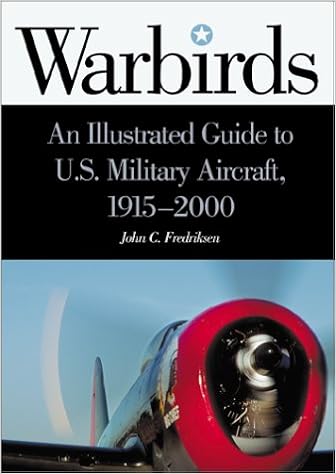By John C. Fredriksen
Warbirds will pay specific consciousness to the plane of America's Golden Age, 1919–1939, and the leap forward technological advancements of that era.
• every one access encompasses a picture of the warplane, carrier dates, producer, files set, engineering and function heritage, technical techniques, or even operational problems
Quick preview of Warbirds: An Illustrated Guide to U.S. Military Aircraft, 1915-2000 PDF
Best Military books
Ship of Rome (Masters of the Sea)
Opposed to a backdrop of the conflict of the Roman and Carthaginian empires, the conflict for sovereignty occurs at the excessive seasAtticus, captain of 1 of the ships of Rome's small, coastal fleet, is from a Greek fishing relatives. Septimus, legionary commander, reluctantly ordered aboard send, is from Rome, born right into a usually military relatives.
Intelligence Analysis: How to Think in Complex Environments (Praeger Security International)
This ebook bargains an unlimited conceptual and theoretical exploration of the methods intelligence research needs to switch so one can be triumphant opposed to latest most threatening opponents and most complicated abnormal theatres of clash. • comprises quotations from quite a lot of acclaimed thinkers• deals an in depth bibliography of works pointed out and assets for additional interpreting• provides a entire index
They're the Army's such a lot elite top-secret strike strength. yet you will not pay attention approximately their heroics at the information, no headlines approximately them can seem within the papers, and no one—not even their families—can recognize who they're. First detailed Forces Operational Detachment-D—Delta strength, America's supersecret counterterrorist unit.
Shadow Warriors: Inside the Special Forces (A Study in Command)
An unconventional conflict calls for unconventional men—the specified Forces.
Green Berets • army SEALS • Rangers •
Air strength precise Operations • PsyOps • Civil Affairs •
and different special-mission devices
The first Commanders books, each guy a Tiger and Into the typhoon, supplied masterly blends of heritage, biography, you-are-there narrative, perception into the perform of management, and undeniable out of date storytelling. Shadow Warriors is all of that and extra, a ebook of unusual timeliness, for, within the phrases of Lieutenant basic invoice Yarborough, “there are itches that merely designated Forces can scratch. ”
Now, Carl Stiner—the moment commander of SOCOM, the U. S. certain Operations Command—and Tom Clancy hint the transformation of the specific Forces from the small center of outsiders of the Fifties, in the course of the cauldron of Vietnam, to the rebirth of the SF within the overdue Eighties and Nineties, and on into the hot century because the bearer of the most important, so much combined, and most complicated set of missions within the U. S. military.
These are the first-hand money owed of infantrymen scuffling with outdoors the strains: counterterrorism, raids, hostage rescues, reconnaissance, counterinsurgency, and mental operations—from Vietnam and Laos to Lebanon to Panama, to Saudi Arabia, Kuwait, and Iraq, to the recent wars of today…
- Operations and Safety Manual for 1911-A1 pistol
- Alesia 52 BC: The final struggle for Gaul (Campaign,Volume 269)
- George Washington's Army (Men-at-Arms, Volume 18)
- Consolidated B-24D-M Liberator in USAAF-RAF-RAAF-MLD-IAF-CzechAF & CNAF service, PB4Y-1/2 Privateer in USN-USMC-Aeronavale & CNAF service (Aircam Aviation, Volume 11)
- 30th Punjabis (Men-at-Arms, Volume 31)
Additional resources for Warbirds: An Illustrated Guide to U.S. Military Aircraft, 1915-2000
In 1935 Douglas responded by fielding its DB1, which was based on the successful DC2 commercial transport. The B18, as it came to be called, was a midwing, twinengine, allmetal design with good range, payload, and speed for its day. More importantly, it could be had for onethird less than its closest competitor, Boeing’s XB17, a clearly superior craft. The Army chose to go with quantity, and in 1936 it awarded Douglas a contract for 133 B 18s. In 1937 this was followed up by an order for 217 improved B18As, which featured a totally redesigned nose that gave it an unmistakable sharklike profile. By the advent of World War II, the B18, unofficially known as the Bolo, was America’s most numerous bombardment aircraft. Several had been caught on the ground and destroyed at Pearl Harbor in 1941 and saw no part in operations against the Japanese. The Army Air Force realized the futility of pressing the Bolos into frontline service, so 122 of the surviving aircraft were modified as B18Bs, the first aircraft to be fitted with magnetic anomaly detection (MAD) equipment. They were dispatched to the Caribbean Sea in 1942 and managed to sink two German Uboats before being replaced by the far superior B24 Liberators. The B18 served out its final days as a transport and training aircraft before being retired in 1944. Type: Heavy Bomber Dimensions: wingspan, 89 feet, 6 inches; length, 57 feet, 10 inches; height, 15 feet, 2 inches Weights: empty, 16,321 pounds; gross, 27,673 pounds Power plant: 2 × 1,000–horsepower Wright Cyclone R1820 radial engines Performance: maximum speed, 215 miles per hour; ceiling, 23, 900; maximum range, 1,200 miles Armament: 3 × . 30–caliber machine guns; 6,500 pounds of bombs Service dates: 1937–1944 Page 107 Douglas B23 Dragon The B23 was a vast improvement over the earlier B18 and was the first American bomber to be equipped with a manned tail gun. However, it was rapidly overtaken by more modern designs and enjoyed only a brief service life. In 1938 Douglas sought to improve its existing B18 by offering the Army Air Force a drastically modified form. The new craft featured a longer wing, a smaller fuselage crosssection to reduce drag, and more powerful engines. The prototype flew for the first time in July 1939, and its performance was promising enough for the Army to order 38 production copies for evaluation. They passed into service as the B23 Dragon and displayed a marked improvement in performance over the older Bolos, being 66 miles per hour faster and possessing a longer range. This was also the first American design to incorporate a manned tailgun position to defend against stern attacks. Unfortunately, the B23 had no sooner been deployed than the military decided it had fallen behind prevailing European designs in terms of speed, armament, and functionality. It was also markedly inferior to the North American B25, the Martin B26, and Boeing’s new B17E, which was the first combatready model of that famous bomber.





